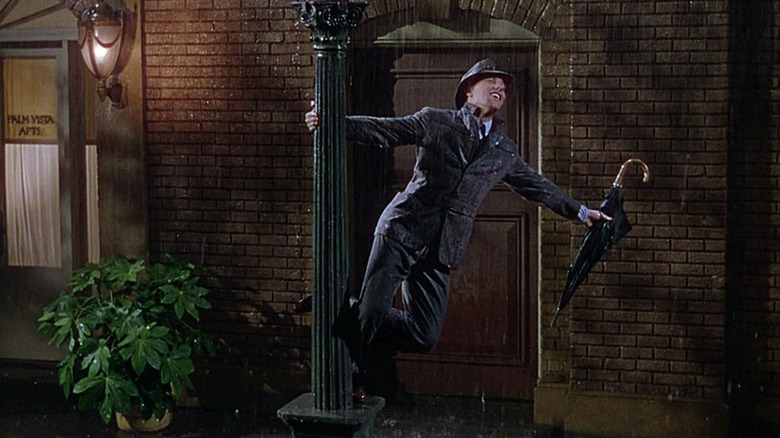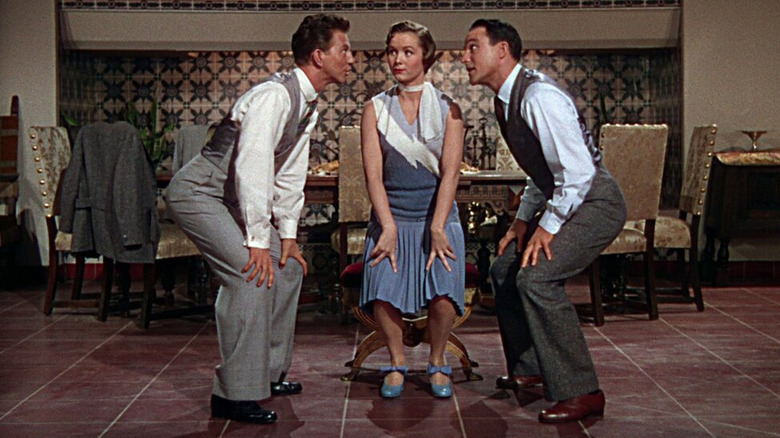Singin' In The Rain's Titular Rain Turned The Soundstage Into A 'Sauna'
70 years after its original release, the influence of musical juggernaut "Singin' in the Rain" is immeasurable. A Hollywood satire filled to the brim with show-stopping musical numbers from Nacio Herb Brown with lyrics by Arthur Freed, its DNA is present in the likes of modern movie musicals like "La La Land," and its whimsical, love-struck title song still gets airplay in PNC Park in star Gene Kelly's hometown anytime the Pittsburgh Pirates catch a rain delay.
For all of its extravagance and pomp, the story of a trio of showbiz performers grappling with the advent of "talkies" in Hollywood had a modest reception upon its original 1952 release, and would collect just a handful of awards in its day. Over the decades, though, the movie (which was co-directed by Kelly and Stanley Donen) grew in reputation, and by 1989, the Library of Congress recognized its "cultural, historical, and aesthetic significance," preserving it in the National Film Registry for posterity. Its cast of stars (Donald O'Connor jumping off walls! Cyd Charisse vamping it up!) and parade of color demand repeat viewings, but /Film's Hoai-Tran Bui has a pure, simple reason for loving it: "No one's doing it like Gene Kelly, and maybe no one ever will."
The film's most known and oft-imitated sequence sees Kelly's silent film star Don Lockwood all googly-eyed, singing "the sun's in my heart, I'm ready for love." The dance routine that ensues is athletic and elegant; Gene Kelly seemingly defies the weight of the water and glides with the grace of a ballerina on a bone-dry stage. But in an interview with NPR, co-director Donen ("Seven Brides for Seven Brothers") gave the play-by-play behind the movie's triumphant dance number and revealed that Kelly splashed and tap-danced in less-than-ideal conditions.
'Come on with the rain, I've a smile on my face...'
"Singin' in the Rain" (both the song and the feature) is the kind of aggressive whimsy that MGM bountifully churned out in its run of post-WWII musicals. In his book "Gods Like Us," scholar Ty Burr posits that the revered legacy of MGM musicals is due to their ability to showcase a great do-it-all star — as he says, those musicals are "the one genre in which an MGM star can actually cut loose." Gene Kelly would indeed make the most of his screen time, breaking out his song-and-dance skills with such dexterity that today, every real-world rain puddle is a temptation to attempt the title song's choreography.
According to Donen, the rainwater seen in the scene was local, piped into the MGM Studios set from Culver City's water supply. Overhead pipes provided the downpour, while clever backlighting made the rain visible onscreen (not milk, as the debunked rumor claims). The temperature of the water was very important — if it was too cold, a dancer's muscles might protest. "On the contrary," Donen explained, "it was so hot in there, it would have been nice if the water had been cool." As he told NPR's Dave Davies:
"We were in mid-summer, and we were under black canvas. So — in the bright daylight, we didn't shoot it at night — in real night. And the sun beating down on a black canvas overhead with the water pouring down on it, it was like a sauna in there. It would have been better to have refrigerated water in that case."
Watching the scene (which was filmed in the summer of 1951), it's impossible to tell that Kelly's dancing in a swampy environment or that he was battling a fever while shooting take after take. "Singin' in the Rain" stands as not only one of the greatest musicals of all time, but a Golden Age vehicle for one of the genre's greatest stars.

